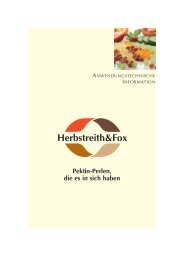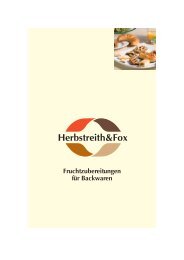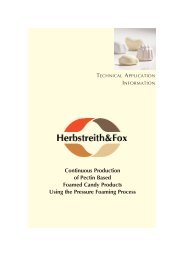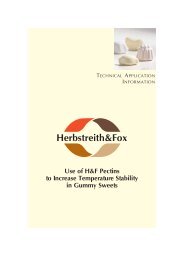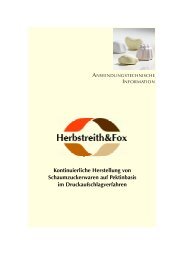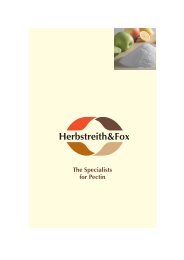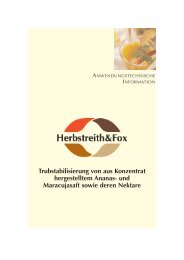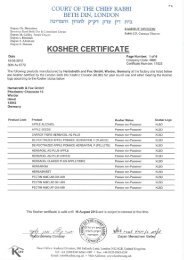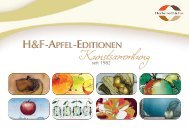Yoghurt Fruit Preparations - Herbstreith & Fox
Yoghurt Fruit Preparations - Herbstreith & Fox
Yoghurt Fruit Preparations - Herbstreith & Fox
Create successful ePaper yourself
Turn your PDF publications into a flip-book with our unique Google optimized e-Paper software.
Range 1:<br />
When calcium ions are added to the formulation<br />
a weak pectin network develops, rendering<br />
the fruit preparation more viscous at first<br />
and finally building up a yield point. The value<br />
of the yield point increases as the calcium ion<br />
concentration increases. In this range, the<br />
products are not yet elastically gelled, but are<br />
highly viscous and very smooth with a high<br />
regenerative capacity.<br />
When the fruit preparation is stirred into the<br />
yoghurt, there is a distinct reaction with the<br />
calcium ions of the milk product as the added<br />
pectin is not yet saturated with the calcium<br />
ions.<br />
Range 2:<br />
As the calcium ion concentration increases, the<br />
fruit preparations become firmer, the yield<br />
point further increases and gel formation<br />
gradually starts. Products in this range are<br />
characterised by their spreadability, glossy<br />
texture and high regenerative capacity.<br />
When the fruit preparation is stirred into the<br />
yoghurt, no reaction with calcium ions from<br />
the milk product can be detected sensorily<br />
once a specific minimum calcium dosage<br />
([Ca 2+ ] min.) is reached. At this point the pectin<br />
is saturated under the selected conditions.<br />
This range is the preferred working range for<br />
yoghurt fruit preparations used in layered<br />
products or in fruit-corner products.<br />
Range 3:<br />
If the calcium dosage is further increased,<br />
elastically gelled gels with a high yield point<br />
are obtained. In this range, fruit preparations<br />
lose part of their regenerative capacity, as the<br />
yield point in the resting phase is partly due to<br />
an elastic gelation. This part of the yield point<br />
is not able to regenerate as it has been irreversibly<br />
destroyed by the shear stress.<br />
Range 4:<br />
From a certain calcium dosage onwards, pregelation<br />
will occur under the selected conditions,<br />
rendering the fruit preparations smoother<br />
and gradually lowering the yield point.<br />
In this range, the texture of the fruit preparations<br />
is soft and creamy with low regenerative<br />
capacity.<br />
A reaction with the calcium ions from the milk<br />
product is not to be expected as the amount<br />
required for saturation was already exceeded<br />
at lower calcium dosages (range 2).<br />
Range 4 is the preferred working range for<br />
fruit preparations used in stirred yoghurts.<br />
Range 5:<br />
With further calcium overdosing, the prege -<br />
lat ion results in products with a rough, course<br />
gel texture, of little regenerative capa city and<br />
a strong tendency to syneresis.<br />
35<br />
Pectins in <strong>Yoghurt</strong> <strong>Fruit</strong> <strong>Preparations</strong>



